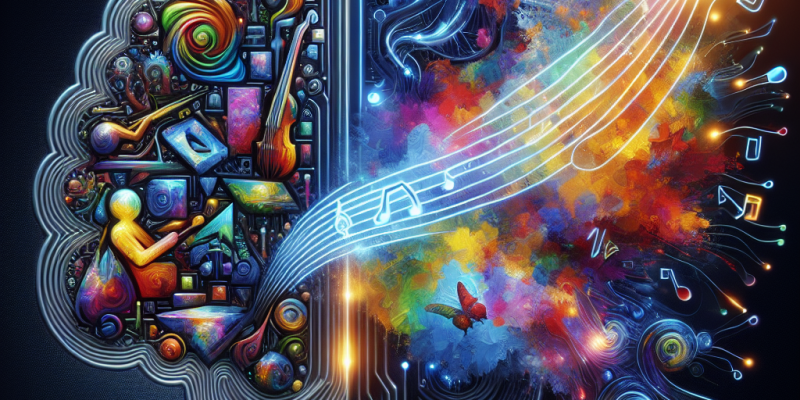AI-Powered Creativity: Exploring the New Frontier in Art and Music

AI-Powered Creativity: Exploring the New Frontier in Art and Music
In recent years, the advent of artificial intelligence (AI) has ushered in a transformative era across various domains, and the creative arts are no exception. AI is not merely a tool for enhancing human creativity; it is increasingly becoming an essential collaborator, giving rise to an entirely new frontier in the realms of art and music. This article delves into the fascinating intersection of AI and creativity, examining how these technological advances are reshaping artistic expression and challenging our understanding of the creative process.
The Rise of AI in Art
AI’s inaugural steps into the world of visual arts can be traced back to the development of algorithms that analyze and generate images. Tools like DeepArt and DALL-E utilize deep learning to produce artwork that ranges from photorealistic to abstract. These AI systems can be trained on vast databases of existing artwork, enabling them to mimic different styles, combine ideas, and even create entirely new concepts. A notable event that captured global attention was the sale of the AI-generated artwork "Edmond de Belamy" at Christie’s, which fetched over $432,000, highlighting both the potential and the intrigue of AI in creative fields.
Collaboration, Not Replacement
One of the most compelling aspects of AI in art is its role as a collaborator rather than a replacement for human artists. AI can act as a source of inspiration, presenting artists with novel ideas or variations that they might not have considered. For example, artists can use generative adversarial networks (GANs) to explore different palettes, styles, and compositions, pushing the boundaries of their artistic practice. This partnership allows for a dynamic interplay, where the artist’s vision is enhanced rather than overshadowed by technology. Many contemporary artists, like Refik Anadol and Mario Klingemann, actively incorporate AI into their creative processes, producing projects that interrogate the nature of authorship and creativity in the digital age.
The Evolution of Music through AI
In the realm of music, AI is leaving a significant imprint on composition, production, and performance. Machine learning algorithms can analyze existing music to learn patterns of melody, harmony, and rhythm, enabling the generation of original compositions in various genres. OpenAI’s MuseNet and Google’s Magenta project are prime examples of AI tools capable of creating complex, multi-instrumental pieces that can rival the works of human composers.
Additionally, AI is being leveraged in music production, assisting with mastering tracks, arranging compositions, and even generating lyrics. For musicians, AI can serve as a creative partner, helping to brainstorm ideas and providing a sounding board for new concepts. Artists such as Taryn Southern and YACHT have explored this intersection, releasing albums with AI-assisted compositions, thus demonstrating the expanding possibilities of music-making in the digital age.
Redefining Creativity and Authorship
The emergence of AI in creative fields raises essential questions about the nature of creativity and authorship. If an AI can produce a compelling artwork or song, who is the true creator? Is it the artist who provides the initial input, the programmer who designed the algorithm, or the algorithm itself? This dialogue challenges traditional notions of creativity, pushing us to define authorship in broader terms. In a world where human and machine creativity intersect, the lines become blurred, fostering discussions about originality, inspiration, and the essence of artistic expression.
Ethical Considerations and Future Implications
As AI continues to permeate the creative landscape, it brings forth ethical considerations that merit attention. Issues surrounding copyright, ownership, and the potential for bias in algorithmic outputs must be critically evaluated. Furthermore, the commercialization of AI-generated art raises questions about the exploitation of artists and the potential commodification of creative works. It is crucial to navigate these challenges thoughtfully, ensuring that AI serves to enhance, rather than undermine, the artistic community.
Looking ahead, the future of AI-powered creativity seems promising. As technology evolves, we can expect more sophisticated algorithms capable of dynamic interaction with human users, leading to even richer artistic outcomes. Institutions, galleries, and platforms that embrace AI as a legitimate and innovative medium will likely shape the future landscape of the arts.
Conclusion
AI is redefining creativity in art and music, challenging pre-existing boundaries and inviting us to reconsider what it means to create and innovate. As artists and technologists continue to collaborate, we enter a new era where human expression combines with machine intelligence, expanding our understanding of creativity itself. The journey into this new frontier is just beginning, and the potential for discovery is as limitless as the imagination itself.














